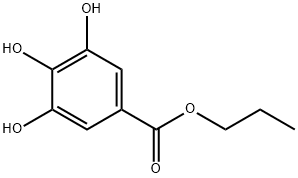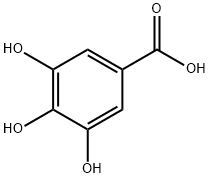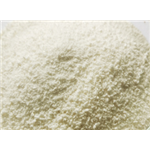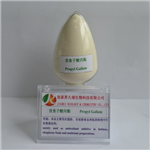Description
Propyl gallate (also known as propyl 3, 4, 5-trihydroxybenoate) is a kind of ester formed through the condensation of gallic acid and propanol. It appears as a fine white to creamy-white crystalline powder. It has long been used as a kind of antioxidants to be supplied to foods especially animal fats and vegetable oil, being especially effective with polyunsaturated fats. Propyl gallate, as an anti-oxidant, can protect the food and oils from the attack of hydrogen peroxide and oxygen free radicals, having an effect similar to the superoxide dismutase. It can also be applied to ethers, emulsion, waxes, and transformer oil as the antioxidants.
References
https://pubchem.ncbi.nlm.nih.gov/compound/propyl_gallate#section=Top
https://en.wikipedia.org/wiki/Propyl_gallate
http://www.hmdb.ca/metabolites/HMDB33835
Description
It caused
contact dermatitis in a baker and in a female confectioner
who fried doughnuts, primarily sensitized by
her night cream; the margarine probably contained
gallates.
Description
Propyl gallate is an antioxidant with antimicrobial activity. It is hepatoprotective
in vitro and
in vivo, preventing CCl
4 induced lipoperoxidation and reduction in polysomes in rat liver. Propyl gallate (100 mg/kg, i.p.) increases expression of HIF-1α, EPO, and VEGF mRNA levels and the number of normal neurons in rat brains after 8 minutes of forebrain ischemia. Propyl gallate in combination with potassium sorbate is bactericidal and bacteriostatic against
S. aureus strains known to produce enterotoxins in food. Propyl gallate is commonly added to foods to prevent autoxidation and microbial growth.
Chemical Properties
white to light beige crystalline powder
Chemical Properties
Propyl gallate is an odorless powder having a slightly bitter taste. It functions particularly well in stabilizing animal
fats and vegetable oils. With a melting point of 148°C, propyl gallate loses its effectiveness during heat processing and is therefore
not suitable in frying applications that involve temperatures exceeding 190°C. Propyl gallate chelates iron ions and forms an unappealing,
blue–black complex. Hence, it is always used with chelators such as citric acid to eliminate the pro-oxidative iron and copper
catalysts. Good synergism is obtained with BHA and BHT; however, application with TBHQ is not permitted. For additional details,
refer to Burdock (1997).
Uses
Propyl Gallate is an antioxidant that is the n-propylester of 3,4,5-tri-
hydroxybenzoic acid. natural occurrence of propyl gallate has not
been reported. it is commercially prepared by esterification of gallic
acid with propyl alcohol followed by distillation to remove excess
alcohol.
Uses
Propyl Gallate is a known inhibitor of Tyrosinase, a polyphenol oxidase, which is an important enzyme in pigment biosynthesis in various organisms. It has also recently been seen to boost biodiesel li
pid biosynthesis in cultures.
Uses
Antioxidant for cosmetics, foods, fats, oils, ethers, emulsions, waxes, transformer oils.
Production Methods
The preparation process of propyl gallate incldues the following steps: under the action of toluene-p-sulfonic acid as catalyst making gallic acid and n-propyl alcohol produce reaction at high temp., reflux and dehydration for 4-7 hr., distilling to recover excess solvent, dissolving residue by adding water, cooling, centrifuging (or filtering) to obtain crude product, decolouring and drying to obtain finished product. Its product propyl gallate yield rate can be up to 98%, and its cost is low.
Preparation
Produced commercially by the esterification of gallic acid with propyl alcohol followed by distillation to remove the
excess alcohol.
Definition
ChEBI: N-propyl gallate is a trihydroxybenzoic acid.
General Description
Fine white to creamy-white crystalline powder. Odorless or with a faint odor. Melting point 150°C. Insoluble in water. Slightly bitter taste.
Air & Water Reactions
Insoluble in water.
Reactivity Profile
Propyl gallate can react with oxidizing agents. Incompatible with strong acids, strong bases and strong reducing agents. Darkens in the presence of iron and iron salts. Contact with metals should be avoided .
Hazard
Use in foods restricted to 0.02% of fat con-
tent.
Fire Hazard
Propyl gallate is combustible.
Flammability and Explosibility
Not classified
Biochem/physiol Actions
An antioxidant that exhibits antimicrobial activity. Propyl gallate has been reported to be an effective antioxidant-based hepatoprotector, both in vitro and in vivo. It has also been shown to prevent neuronal apoptosis and block the death of neurons exposed to FeSO4/GA as well as partially protect endothelial cells against TNF-induced apoptosis.
Contact allergens
This gallate ester (E 311) is an antioxidant frequently
used in the food, cosmetic, and pharmaceutical industries
to prevent the oxidation of unsaturated fatty acids
into rancid-smelling compounds. It causes cosmetic
dermatitis mainly from lipsticks and induced contact
dermatitis in a baker, and in a female confectioner, primarily
sensitized by her night cream, who fried doughnuts
the margarine probably containing gallates.
Toxicology
Propyl gallate (n-propyl-3,4,5-trihydroxybenzoate) is used in vegetable oils and butter. When 1.2 or 2.3% propyl gallate was added to feed for rats, loss of weight was observed. This may be due to the rats reluctance to eat food that was contaminated with the bitter taste of propyl gallate. When it was given for 10 to 16 months at the 2 to 3% level, 40% of the rats died within the first month and the remainder showed severe growth inhibition. Autopsies of rats indicated kidney damage resulting from the ingestion of propyl gallate. However, no other animal studies show serious problems and further studies indicated that propyl gallate does not cause serious chronic toxicities.
Safety Profile
Poison by ingestion and
intraperitoneal routes. Experimental
teratogenic and reproductive effects.
Questionable carcinogen with experimental
tumorigenic data. Mutation data reported.
Combustible when exposed to heat or
flame; can react with oxidizing materials.
When heated to decomposition it emits
acrid smoke and irritating fumes.
Safety
Propyl Gallate currently is used as an antioxidant in a reported 167 cosmetic products at maximum concentrations of 0.1%. Propyl Gallate is a generally recognized as safe (GRAS) antioxidant to protect fats, oils, and fat-containing food from rancidity that results from the formation of peroxides.
Purification Methods
Crystallise the ester from aqueous EtOH or *C6H6 (m 146-146.5o). [Beilstein 10 III 2078, 10 IV 2003.]








